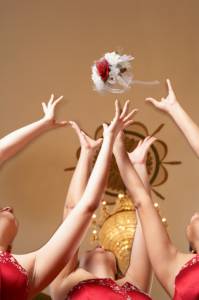 All couples are different, and a wedding that reflects their personalities and preferences is a common goal. In Canada, many wedding customs incorporated in the celebration are influenced by European-Christian, particularly British, traditions.
All couples are different, and a wedding that reflects their personalities and preferences is a common goal. In Canada, many wedding customs incorporated in the celebration are influenced by European-Christian, particularly British, traditions.
The White Dress
A conventional white wedding dress, purchased specifically for the occasion, is still the most popular choice of Canadian brides. The custom of wearing white started in the Victorian Era and symbolized purity.
Something Old, Something New
It is considered good luck for brides to wear “something old, something new, something borrowed and something blue.” The tradition originated from an old English rhyme. The fifth and final item referenced in the rhyme, not usually adhered to outside of Britain, is “a sixpence in your shoe.”
- “Old” stands for continuity. Some brides choose to wear a family heirloom.
- “New” represents optimism for the future. The wedding dress or shoes can be two examples.
- “Borrowed” represents borrowing joy from a happily married couple in hopes it rubs off on your own relationship. A piece of jewelry or handkerchief are items that can be borrowed.
- “Blue” is meant to represent loyalty and fidelity. Brides sometimes wear blue garters or tie a blue ribbon in their bouquet.
- “A sixpence in your shoe” is the desire for prosperity and good fortune.
The Groom Stands on the Right
Many couples still choose to get married in a church, but there are numerous other options including gardens, beaches and the homes of family and friends. No matter where the ceremony occurs, it is customary for grooms to stand on the right side and brides on the left while they exchange vows. This tradition evolved in Europe centuries ago. Grooms needed easy access to their swords in the event someone attempted to abduct their brides. While there is no longer a worry of brides getting kidnapped at the altar in modern day Canada, the custom has endured.
Bridal Party
Having a bridal party is an Anglo-Saxon tradition. Grooms would have knights assist their brides in getting to ceremonies safely. The knights would also escort couples back home to prevent them from being attacked and their dowries stolen.
Bouquet Toss
It is traditional for a bride to carry a bouquet of flowers and toss it towards all the single women after the wedding. Whoever catches it is supposed to be the next to marry. This custom originated from brides wanting to protect their dresses from unmarried women who would rip bits off the gowns for good luck. Brides started throwing pieces of bouquets towards them so they would have something pretty and not try to tear off their dresses.
Honeymoon
Many couples go on a honeymoon after they are married. The term “honeymoon” comes from a traditional drink couples would consume. They would drink mead wine, which was made from fermented “honey” and water, for a month after their wedding. The month represents a full cycle of the “moon.”
New Wedding Trends
While traditions are practices and rituals that have stood the test of time, trends are much more recent and easily come and go. Here are some current wedding trends.
- Bite-Sized Desserts
As an alternative to the big wedding cake, it is becoming popular to offer individual bite-sized desserts. They can be served off a tray at each table.
- Metallic Accents
Metallic accents are popping up everywhere. Foil on invitations, floral table decorations in gold and silver vases and metallic specks on desserts are all ways to add some sparkle to the occasion.
- Chef Interaction
Instead of traditional buffets or sit down dinners served by waiters, more couples are ditching convention when it comes to cuisine and letting their guests interact with chefs.
Weddings often include traditions. However, it is also fun to mix some new trends into the festivities.


